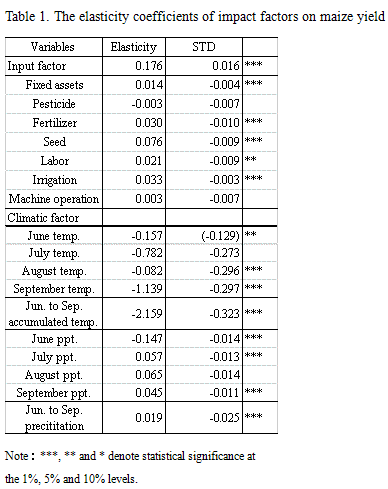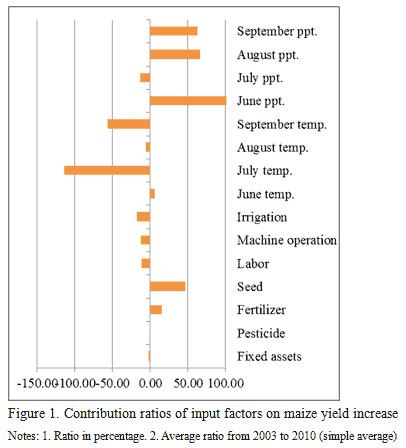Influence analysis of climatic and input factors on maize yield in Hebei Province
Description
When China became a net maize-importing country in 2010, full attention was given to the possibility of further increasing domestic supply capability. As the expansion of arable land nears its limit, further increase in supply can only be achieved by increasing maize yield. However, increasing maize yields is very difficult due to the deterioration of production environment caused by excessive use of chemical fertilizer, climate change, and shortage of farm labors. As Hebei Province is among the three biggest maize-producing provinces and the fact that maize supply depends mainly on its yield, clarifying the main factors that influence yield is important for predicting maize supply trends. Further, this study may also lead to risk analysis and policy making for stable production. Farmer household survey data of nine counties in Hebei Province were used in the study, taking into account the various regional differences, in order to achieve higher accuracy.
We built several analytical models, including the ordinary least squares (OLS) regression, the maximum likelihood (ML), and the residual maximum likelihood (REML) multilevel models, to analyze the impact of input and climatic factors on maize yield using survey data collected between 2003 to 2010 from 4152 farmer households. Based on the results of panel analysis, the ML model was selected for its good modeling capacity. The model was used to estimate the elasticity and the contribution ratio of input factors (seed, chemical fertilizer, pesticide, fixed asset, labor, machine operation, irrigation) and climatic factors (temperature, precipitation) on maize yield.
The elasticity of inputs affecting maize yield is 0.176. As for the climatic factors (during the growth period from June to September), the elasticity of temperature is -2.159 and the elasticity of precipitation is 0.019. While the influence of precipitation is positive, the influence of temperature is negative and quite big. Specifically, the negative impact on yield due to high temperature in September is significant (Table 1).
Regarding the influence of input factors on maize yield, the positive effect of fixed assets, labor, chemical fertilizer, irrigation, and seed selection has been confirmed. The elasticity of seed selection is 0.076, which is higher than other inputs and reveals the fact that seed selection is important for yield increase (Table 1).
As shown by the contribution ratio of each factor for yield increase during the measurement period, moderate rainfall in June, August, and September, as well as seed selection, produced positive contributions. On the other hand, high temperatures in July and September led to negative contributions. The influence of climatic factors was relatively large.
The analytical method based on panel data analysis should also be applied to similar studies in areas other than Hebei Province. By doing so, it is hoped that the accuracy of supply predictions can be improved. To obtain influence parameters for median and long-term supply predictions, the measurement period should be further increased.
Figure, table
- Affiliation
-
Japan International Research Center for Agricultural Sciences Social Sciences Division
- Classification
-
Administration B
- Research project
- Program name
- Term of research
-
FY 2012 (FY 2011-FY 2013)
- Responsible researcher
-
Hsiaoping Chien ( Social Sciences Division )
Ma J. ( China Agricultral University )
Yongfu Chen ( China Agricultral University )
Kusano Eiichi ( Social Sciences Division )
- ほか
- Publication, etc.
-
Chen Y. et al. Journal of Integrative Agriculture, 12(1), pp.101-108.
Ma, J. et al. (2012), Chinese rural economics, 2012(11): 11-20
Hsiaoping, Chien et al. (2012), Noson to Toshi wo musubu, 734(12): 60-63
- Japanese PDF
-
2012_18_A4_ja.pdf48.25 KB
- English PDF
-
2012_18_A4_en.pdf66.4 KB


